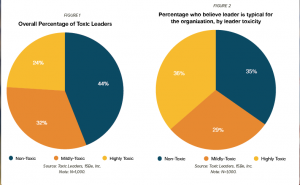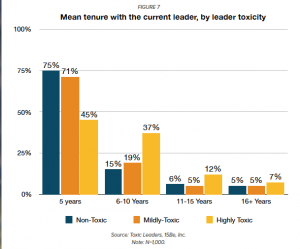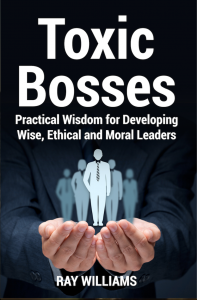By Ray Williams
April 5, 2021

Research shows there are plenty of toxic bosses in organizations. They exist on a spectrum from the psychopath to the charismatic narcissistic or abusive leader. Yet, most of us are familiar with toxic leaders who continue to be successful, and don’t pay the price for their toxic behavior.
Do they continue to be successful? Or are they finally weeded out?
Toxic personality is a term used to describe people who behave greedily, immodestly and unfairly and take the truth very lightly. Dr. Mareike Kholin, Bastian Kückelhaus and Prof. Dr. Gerhard Blickle from the Department of Psychology at the University of Bonn found out why such people can still succeed in their careers. The trick that leads to the top is social skill. The results are published in the journal “Personality and Individual Differences.”
Social skills are in themselves a good thing in the workplace. They can open locked doors and help to cope with daily stress. But they can also be used to deceive others, abuse trust or construct a façade of harmlessness beyond which actually lurks deceitfulness. Dr. Mareike Kholin and the research team determined that toxic personalities who are considered socially adept by their colleagues were considered more capable by their superiors and occupy a higher hierarchical position. “We have to get used to the idea that social skills can be a double-edged sword,” says Kholin.
In personality tests, “toxic” persons have low scores in the categories “honesty” and “modesty.” “Such personalities tend to focus on themselves all the time,” says Blickle. “Good social skills enable them to deceive others.” On the other hand, those who are distinctly honest and modest are a real joy for their team: Such individuals behave fairly and allow colleagues to share in their successes.
Low Values for the Characteristics “Honesty” and “Modesty”
Psychologists Kholin and Biclkle investigated the phenomenon by interviewing various work teams: First the participants completed an anonymous online survey and assessed themselves on the characteristics “honesty” and “modesty,” among others. Then colleagues provided information on the social skills of the participant. The participant’s supervisor then gave an appraisal of his work performance. The researchers were able to collect data from a total of 203 of such “trios” of employees, colleagues and superiors.
The results showed that workers with low values for honesty and modesty can nonetheless succeed in their careers if they balance the toxic parts of their personality with social skills. Bastian Kückelhaus: “Trickery, disguise and deception are the dark side of social skills.”
How Can Toxic Leaders Be Assessed More Accurately?
But how can companies and teams respond to these findings? “In order to slow down the ascent of toxic personalities, more attention should be paid to actual performance and less to the good impression when selecting staff and making assessments,” advises Prof. Blickle. This is particularly difficult in activities where it is important to impress and arouse interest, such as in sales or leadership positions. “Here, it makes sense for instance to also look at the sickness and notice rate of employees, or customer loyalty,” Blickle adds.
Psychogists and researcher Emily Grijalva at the University of Illinois at Urbana-Champaign found in her research published in the journal Personnel Psychology,that narcissists can be effective leaders — to a point.
According to Grijalva, narcissists have an exaggerated sense of their own self-importance, an exaggerated need for others’ admiration and a lack of empathy.”They can be preoccupied with thoughts and fantasies of their enormous success, power, attractiveness and intelligence,” Grijalva said. “They are addicted to others’ admiration. And in the long term, they’re not very good at maintaining positive, interpersonal relationships with others.”
“Narcissists tend to be extraverted, and that is leading to the positive relationship between narcissism and leader emergence,” Grijalva said. “But you have to keep in mind that although narcissists are likely to emerge as the group leader, over time, the more negative aspects of narcissism tend to emerge.”She said that these negative characteristics include “being exploitative, arrogant and even tyrannical,” adding that these attributes “aren’t really prototypical of effective leadership.”
A research study completed by Charles A. O’Reilly III at Stanford’s business school surveyed employees in 32 large, publicly traded tech companies. He contends that bosses who exhibit narcissistic traits like dominance, self-confidence, a sense of entitlement, grandiosity and low empathy, tend to make more money than their less self-centered counterparts, even if the lower-paid CEOs exhibit plenty of confidence.
Success to a Point and Then….
Michael Maccoby in his book, The Productive Narcissist: The Promise and Peril of Visionary Leadership, details how narcissistic leaders have thrived in organizations, particularly in Silicon Valley, are where abusive leaders thrive.Productive narcissists are not only risk takers willing to get the job done but also charmers who can convert the masses with their rhetoric. The danger is that narcissism can turn unproductive when, lacking self-knowledge and restraining anchors, narcissists become unrealistic dreamers, Maccoby argues, in his article in the Harvard Business Review: “They nurture grand schemes and harbor the illusion that only circumstances or enemies block their success. This tendency toward grandiosity and distrust is the Achilles’ heel of narcissists. Because of it, even brilliant narcissists can come under suspicion for self-involvement, unpredictability, and — in extreme cases — paranoia.”
Maccoby concludes “But with the dramatic discontinuities going on in the world today, more and more large corporations are getting into bed with narcissists. They are finding that there is no substitute for narcissistic leaders in an age of innovation. Companies need leaders who do not try to anticipate the future so much as create it. But narcissistic leaders — even the most productive of them — can self-destruct and lead their organizations terribly astray. For companies whose narcissistic leaders recognize their limitations, these will be the best of times. For other companies, these could turn out to be the worst.”
Despite Their Success, Toxic Leaders Create Long Term Chaos
A new paper by Berkeley Haas Prof. Jennifer Chatman and colleagues shows not only the profound impact narcissistic leaders have on their organizations, but also the long-lasting damage they inflict. Like carriers of a virus, narcissistic leaders “infect” the very cultures of their organizations, the researchers found, leading to dramatically lower levels of collaboration and integrity at all levels — even after they are gone.
In previous research about toxic leaders, Chatman and her colleagues found that narcissistic CEOs have a dark sidethat reveals itself slowly over time. Their exploitative, self-absorbed behavior sets them apart from the charismatic, “transformational” leaders they are often confused with. They are also paid morethan their non-narcissistic peers, and there’s a larger gap between their pay and those of other top executives in their companies, often because they are so good at unfairly claiming credit for other’s accomplishments. Narcissistic leaders get their companies involved in more lawsuits, as well, Chatman and her colleagues’ research has found.
Narcissistic leaders have personalities that are profoundly grandiose, overconfident, and dishonest, credit-stealing, and blame-throwing, according to Chatman. They are abusive to their subordinates, think they are superior, don’t listen to experts, create conflict, and believe the rules simply don’t apply to them. They can explode in rage at any sign of disagreement or disloyalty. There’s always an “I” in their conception of the team.
In their latest paper, Chatman and her colleagues conducted a series of five experiments on 1,862 test subjects, as well as a field study that included CEOs of major companies, to discern the impact of narcissists’ bad behavior. The results show not only that leaders high on the narcissism scale are less collaborative and ethical, but also that the cultures of the organizations they lead are less collaborative and ethical. Ultimately, the researchers revealed exactly hownarcissists institutionalize less collaborative and ethical behaviors and create lasting damage on employee morale and performance.
“Narcissistic leaders affect the core elements of organizations and their impact on society,” says Chatman, the Paul J. Cortese Distinguished Professor of Management. “Companies organize because they can do something together that no individual could accomplish alone. When narcissistic leaders undermine collaboration, they by definition reduce the effectiveness of an organization. Without integrity, an organization risks its very survival.”
How Narcissists Affect Organizations
There’s a colorful saying that the “fish rots from the head down” — employees see leaders acting like jerks, and they become jerks, too.
But it’s not a simple matter of mimicking the boss. “Narcissists don’t create narcissists,” Chatman says. “It’s not about doing what the leader does. It’s about the leader creating a culture that induces people to act less ethically and less collaboratively than they would otherwise, whether they’re narcissists or not.”
That’s because a key driver of employee behavior is their organization’s culture, not just their leader, says Chatman, a pioneering researcher in the field. “Organizational culture outlasts any leader,” she says. “Even after a leader is gone, the culture that has been cultivated has a life of its own.”
Narcissists infect the culture through the policies and practices that they directly influence, or — more often — that they fail to institute. They often choose not to put in place strong policies governing ethical behavior, conflicts of interest, and pay equity between men and women, as well as practices that promote teamwork and encourage people to treat others with civility and respect. On the flip side, they also frequently fail to sanction employees when they violate these shared norms. In effect, people get rewarded for less ethical, less collaborative behaviors, Chatman says.
Actions such as these create lasting organizational damage. When people aren’t able to collaborate, collective accomplishments become harder to attain. Employees’ ability to learn, grow, and gain new expertise withers. When they see leaders take credit for every success and blame others for every failure, employees’ morale sinks and their self-confidence wilts.
While there’s strong evidence that people who are overconfident and unethical generate lower financial performance and undergo more regulatory investigations of ethical breaches than those who are not, Chatman says the jury is still out about whether narcissistic leaders have a strong impact on long-term company performance. That’s because many external and competitive variables can affect stock prices, revenues, and profitability. Even so, Chatman argues, narcissists’ penchant for becoming embroiled in lawsuits and ethical breaches, being insensitive to risk because of their overconfidence, and creating low employee motivation is a recipe for poor organizational performance.
How to Deal With Narcissistic Leaders
To avoid narcissistic leaders, one obvious solution is to simply not hire them, or allow them to be promoted. Organizations should put special measures in place to screen for these personality types, Chatman says. A common approach involves asking tough questions to uncover negative behaviors from a wide range of references, not just those a leader provides. However, narcissists are often savvy enough to recognize who is going to sing their praises and who isn’t, and will provide a selective list of references. In some cases, executive search firms are enlisted to go beyond references and try to uncover information that is harder to find.
Still, wily narcissists can sometimes evade detection until they’ve been in place for a while. Using 360-degree evaluations from a wide range of employees can help surface self-absorbed leaders, Chatman notes.
Once it becomes clear that a company has a toxic leader at the top, it takes unflagging effort from the board to rein in a narcissist’s worst tendencies, Chatman says. Unfortunately, many boards of directors don’t go far enough in that direction, which is part of the reason why companies have ended up with so many CEOs who are high on the narcissism scale.
Chatman says that one of the best ways to mitigate the damage narcissistic leaders can cause is to base a significant part of their compensation and performance evaluation on the development of their people. Boards can also align a leader’s compensation to the performance of their team, and boards can devise ways to reward collaboration with peers. Measures such as these help ensure leaders cannot circumvent sharing credit and working with others.
Chatman’s findings show that after a narcissist leader gets a strong foothold, removing them is only the first step in repairing the organization. “Boards can’t assume that simply by removing a leader, they will be able to change how people in the organization behave,” she says. “The culture leaders helped create will still be embedded in the policies and practices that reward people for prioritizing uncollaborative and unethical behaviors. Turning around this kind of culture will take explicit effort and likely a significant amount of time.”
Toxic Leadership in the Military
In an article in Military Review by Lieutenant Colonel Joe Doty, Ph.D., U.S. Army, Retired, regarding toxic leaders in the military he argues,“The Army recently released a study reporting that 80 percent of the officers and NCOs polled had observed toxic leaders in action and that 20 percent had worked for a toxic leader. This problem is not new. Within the past few years, the Army has relieved two brigade commanders and a general for alleged toxic — and arguably narcissistic and abusive — behavior. A division commander who served in Baghdad during Operation Iraqi Freedom was “asked” to retire following an investigation of his leadership style and toxic command climate. Toxic leaders have been around for years and will continue to serve in all branches of our military. The Navy has recently relieved a number of commanders owing to toxic behavior and unhealthy command climates.” He goes on to say “Narcissistic leaders support and perpetuate toxicity on a daily basis. As long as the imagined view of a successful leader (whether it is true or not) remains the screaming, yelling, selfish, berating commander standing in front of a soldier or a staff, then it is not likely that we will remove this cultural aspect from our services.”
And in Canada the steady stream of explosive revelations over the last month of alleged misconduct — involving Gen. Jonathan Vance, the former chief of the defence staff and his successor, Admiral Art McDonald, as well as fresh concerns about the possible inappropriate behaviour of Vice-Admiral Haydn Edmundson two decades ago — has sent the military reeling.
Lee Simmons, writing in Insights by Stanford Business, says “What traits do we look for in our leaders? Ask someone what distinguishes a forceful leader, in business or politics, and they’re likely to mention self-confidence and charisma. Great leaders, we say, are bold and strong-willed. They have a vision for creating something new or remaking a company or a country. They challenge conventional wisdom and are slowed by neither self-doubt nor criticism.These are the individuals whom corporate boards tend to select as CEOs, especially in times of upheaval, when the status quo is failing. They’re adept at self-promotion and shine in job interviews. Then, once they’re in power, we find out who they really are.”
Sometimes they’re as good as their promise. But many turn out to be not just confident but arrogant and entitled. Instead of being bold, they’re merely impulsive. They lack empathy and exploit others without compunction. They ignore expert advice and treat those who differ with contempt and hostility. Above all, they demand personal loyalty.
Field studies have shown that narcissistic CEOs are more likely to engage in fraud and other types of white-collar crime, manipulate earnings, and pursue aggressive tax avoidance. And a 2013 study of U.S. presidents found that those who scored higher on the narcissism scale were more likely to abuse their authority.
A report by a workforce consulting firm 15Be by Kevin Matos claims that 56% of employees (1000 surveyed) in 26 industries have endured a toxic leader. Another research study by psychologists Nathan Brooks and Katarina Fritzon of the University of San Diego claims that one in five CEOs can be categorized as psychopaths. Matos also found the following:
- In our study, more than half (56%) of respondents report that their leader is mildly (32%) or highly (24%) toxic.

- More employees working for highly toxic leaders (81%) suspect their leader of discriminating against them than do those working for nontoxic leaders (8%).
- While only 8% of nontoxic leaders are suspected of discriminating, 52% of mildly toxic and 81% of highly toxic leaders are suspected of doing so.
- Graduates of college engineering programs (77%) are the most likely to indicate they have a toxic leader. Graduates of humanities programs (42%) are the least likely to indicate they have a toxic leader.

- Respondents working in goods-producing industries (38%) and infrastructure (34%) industries are the most likely to indicate they have a toxic leader, and those working in government (2%) are the least likely.
- Highly toxic leaders are most common in all-male workplaces (74%) and least common in all-female (13%) and gender-equal (14%) workplaces.

- It is estimated that abusive leaders cost U.S. employers $23.8 billion per year in absenteeism, turnover, legal costs, and reduced productivity. This figure doesn’t take into account health care costs that may arise from working for abusive leaders such as increased likelihood to experience a heart attack or other life-threatening cardiac conditions.
- Our findings support this theory with 63% of employees in high-stakes cultures identifying their leaders as highly toxic, whereas only 1% of respondents in low-stakes cultures identify their leaders that way.
Theo Veldsman of the University of Johannesburg has published a study on the growth and impact of toxic leadership on organizations. He contends that “there is a growing incidence of toxic leadership in organizations across the world.” Veldsman says that anecdotal and research evidence shows that one out of every five leaders is toxic, and he argues according to his research, that is closer to three out of every ten leaders. Veldsman describes toxic leadership as “ongoing, deliberate intentional actions by a leader to undermine the sense of dignity, self-worth and efficacy of an individual. This results in exploitative, destructive, devaluing and demeaning work experiences.” He goes on to say that a toxic organization is one that “erodes, disable and destroys the physiological, psychosocial and spiritual well being of the people who work in it in permanent and deliberate way.”
INSEAD business school Professors Gianpiero Petriglieri and Jennifer Petriglieri, authors of “Can Business Schools Humanize Leadership?” have coined the term “leadership industrial complex,” which they say promotes a view of leadership that is depersonalized and sanitized: “Over one decade of corporate scandals, financial meltdowns and growing inequality has consolidated a disconnect with business and political leaders, as it is in the protests in the streets and squares around the globe.” Leaders now are no longer seen as being role models or stewards of the common good, but rather as predatory plutocrats who profit disproportionately at the expense of the majority of the population. Petriglieri and Petriglieri argue that we have experienced a “dehumanization of leadership” in which leadership is reduced from a cultural enterprise to a strict intellectual or commercial one, and in which leadership “distances aspiring leaders from their followers and institutions, resulting in a disconnect their inner and outer worlds.”
Robert Sutton was one of the first leadership experts to draw attention to the prevalence of abusive bosses and how organizations should screen them out, as detailed in his book, The No Asshole Rule: Building a Civilized Workplace and Surviving One That Isn’t. He points out that tech firms, particularly those in Silicon Valley, are where abusive leaders thrive. His article in the Harvard Business Reviewon the subject received an overwhelming response of affirmation. He says in business and sports it is assumed if you are a big winner, you can get away with being a jerk. Sutton argues such bosses and cultures drive good people out and claims bad bosses affect the bottom line through increased turnover, absenteeism, decreased commitment and performance. He says the time spent counselling or appeasing these people, consoling victimized employees, reorganizing departments or teams and arranging transfers produce significant hidden costs for the company. And he warns organizations this behavior is contagious. Research suggests not only that some bosses are jerks but that many of them are bosses because they are jerks.
Jean Lipman-Blumen, in her book, The Allure of Toxic Leaders, describes how toxic leaders create “serious and enduring harm” on their followers, employees and their organizations. Recent polls of the American public shows some of the lowest trust results in decades for elected members of Congress and business leaders.
Lipman-Blumen contends that even the media has difficulty resisting the seductive appeal of toxic leaders, citing examples from leading publications such as Time, BusinessWeek, Forbes and Fortune extolling the virtues of a number of failed narcissistic and toxic leaders such as Dennis Kozlowski, Kenneth Lay and Al Dunlap.
Lipman-Blumen makes an interesting point in describing the reason why we still continue to follow such destructive leaders. We not only tolerate but also even prefer and create a toxic leader. We always look up to some god-like figure human or divine to take care of us, to create an illusion that we are the heroes and that we are amongst the chosen ones. We can be at the center of the action and thus inspired to join them. These illusions are the conduits through which toxic leaders reach in and grab us. She argues that organizations could also become an incubator of toxic behavior, through counterproductive policies and practices, including unreasonable goals, excessive internal competition and cultures that encourage blame game. Thus, virulent strain by toxic leaders tax heavily on the creativity, innovativeness enthusiasm and sovereignty of the people around them aiming at the fulfillment of only the leader’s interest.
The ratio of toxic leaders to effective leaders is unbalanced and, thankfully, the majority of leaders are not toxic. Walter F. Ulmer estimated in an article entitled “Toxic Leadership” that 30–50% of leaders are essentially transformational, while only 8–10% are essentially toxic. The unfortunate reality is that one toxic leader in an organization can do such incredible damage; he or she can bring down an entire culture without even realizing it. As one rotten apple can spoil the whole basket; one toxic leader is enough for menace.
Leadership toxicity may be an omnipresent facet of organizations; however, it attracts far less consideration than it merits. It is inevitable that a pacesetter as a social personality always stays slanted to the vulnerabilities regardless of their position, professional and educational experience and capability. Many times, the workplace culture and environments are what prompt leaders toward toxicity to some degree. Leadership toxicity is by all accounts an unavoidable part of organizational life undermining individual and organizational performance.
Toxic leadership may be portrayed as a silent killer as it positions leaders as invincible to sabotage, cease, and punish those who question such supremacy. In sum, toxic leadership is an expensive anomaly. It incapacitates individuals, groups and organizations, even nations.
Neglecting to bargain unflinchingly with the multifaceted strengths that encourage our passive consent to toxic leaders will only endorse the decimation such leaders create.
People and the organization define a nation. Toxic leadership could be held responsible not only for organizational but also for the kind of political and economic turmoil that exists in the world. Conflict in interest and intentions of senior leaders of nations and political catastrophes are results of toxicity in leadership.
The experience of a toxic leadership is an organizational cancer with the high-propensity to metastasize, leaving destruction, poison, and scars in its path and beyond. It is an established fact now that the influence of toxic leadership is severely damaging and its effects are far beyond the subordinates, project goals and organization. It percolates deep into the very roots of society jeopardizing growth of a progressive nation.
In my new book, Toxic Bosses: Practical Wisdom for Developing Wise, Ethical and Moral Leaders,where I outline the extent of the problem of toxic bosses in American business and I make the point that the problem is underappreciated and unaddressed to a large extent in organizations. Finally, I offer practical suggestions on what individuals, institutions and organizations can do about it.


